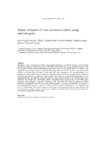Update on hepatitis C virus resistance to direct-acting antiviral agents

View/
Use this link to cite
http://hdl.handle.net/2183/18417
Except where otherwise noted, this item's license is described as Atribución-NoComercial-SinDerivadas 3.0 España
Collections
- Investigación (FCS) [1293]
Metadata
Show full item recordTitle
Update on hepatitis C virus resistance to direct-acting antiviral agentsAuthor(s)
Date
2014-06-06Citation
Poveda E, Wyles DL, Mena A, Pedreira JD, Castro-Iglesias A, Cachay E. Update on hepatitis C virus resistance to direct-acting antiviral agents. Antiviral Res.2014;108:181-191
Abstract
[Abstract] Resistance to direct-acting antiviral (DAA) agents against hepatitis C virus (HCV) infection is driven by the selection of mutations at different positions in the NS3 protease, NS5B polymerase and NS5A proteins. With the exception of NS5B nucleos(t)ide inhibitors, most DAAs possess a low genetic barrier to resistance, with significant cross-resistance between compounds belonging to the same family. However, a specific mutation profile is associated with each agent or drug class and varies depending on the genotype/subtype (e.g., genotype 1b showed higher rates of sustained virological response (SVR) and a higher genetic barrier for resistance than genotype 1a). Moreover, some resistance mutations exist as natural polymorphisms in certain genotypes/subtypes at frequencies that require baseline drug resistance testing before recommending certain antivirals. For example, the polymorphism Q80K is frequently found among genotype 1a (19–48%) and is associated with resistance to simeprevir. Similarly, L31M and Y93H, key resistance mutations to NS5A inhibitors, are frequently found (6–12%) among NS5A genotype 1 sequences. In particular, the presence of these polymorphisms may be of relevance in poorly interferon-responsive patients (i.e., null responders and non-CC IL28B) under DAA-based therapies in combination with pegylated interferon-α plus ribavirin. The relevance of pre-existing resistance mutations for responses to interferon-free DAA therapies is unclear for most regimens and requires further study.
Keywords
Hepatitis C virus
Direct-acting antivirals
Drug resistance
Direct-acting antivirals
Drug resistance
Description
Review
Editor version
Rights
Atribución-NoComercial-SinDerivadas 3.0 España
ISSN
0166-3542
1872-9096
1872-9096






